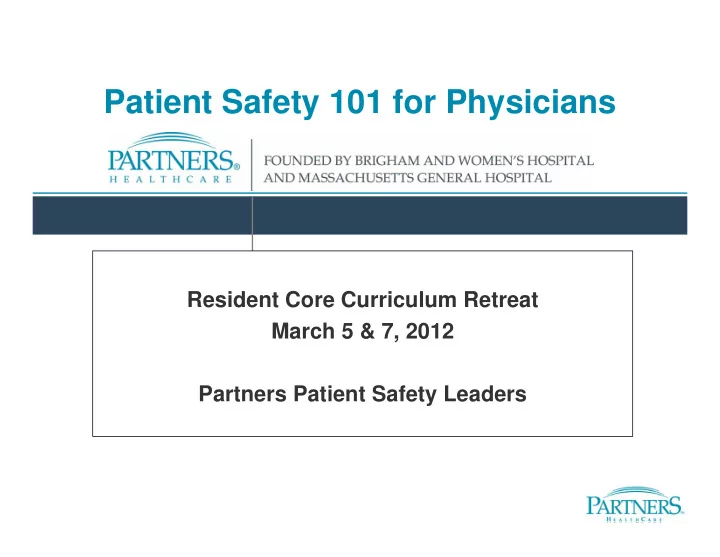

Patient Safety 101 for Physicians Resident Core Curriculum Retreat March 5 & 7, 2012 Partners Patient Safety Leaders
Outline Brief Introduction and Objectives Background and details of safety reporting Video Break into groups and discuss video Closing Thoughts Brief Q+A Please feel free to ask a question at any point in the presentation
Objectives View errors and near misses as a “systems problem” Explain why safety reporting is important to quality healthcare, and how you can help Provide you with instructions on how to file a safety report Provide you the patient safety contact information at your specific institution We want to encourage you to participate in Patient Safety activities A 2008 Joint Commission report showed that physicians reported only 1.1% of total safety events At Partners that average is 5%
Institute of Medicine’s First Quality Report: To Err is Human – November 1999 Preventable Lapses in Safety 44,000 to 98,000 Americans die each year Eighth leading cause of death in the United States Annual cost as much as $29 billion annually IOM conclusion: the majority of these problems are systemic, not the fault of individual providers
How Can You Contribute To Patient Safety? Simple strategy to follow: Identify and report events, near misses, and errors Near Misses constitute 70% of safety reports at Partners and are instrumental in affecting change before there is harm to a patient An unreported error cannot be investigated Perform these improvements Unfortunately, it’s not so simple….
Why Is There Under-Reporting? Culture of blame Medicine and society have tended to fault the person, not the system Health care providers have concern for personal consequences Malpractice Reputation Tedious to report Providers are busy Not a priority
Ways To Improve Increase Overall Reporting First, need to create a culture of safety, similar to the aviation industry Move beyond blaming and punishing and towards improving the system Reduce fear of reporting Show people safety reporting makes a positive impact Simplify reporting (e.g. online or call to risk management) Provide feedback to reporters Prompt reporting (reminders, interviews, multi- disciplinary focus groups)
Safety Reporting System
Examples of Event Types
Telling the Story
Systems Approach to Error Analyze the system for contributing factors that allow errors to occur Vast majority of errors are due to faulty systems Blaming individuals is not going to prevent future errors from occurring Individuals are trying to do their best Goal to streamline and build safeguards into systems
Contributing Factors to Error Systems factors Human factors Staff experience Judgment Staffing levels Communication Supervision Teamwork Policies and procedures Stress Handoffs Fatigue Workflow Environmental factors Patient factors Distractions Language issues Noise Knowledge deficit Precautions Fear Interruptions Disease acuity
The Swiss Cheese Model of System Accidents J.Reason, J.Reason, BMJ BMJ 2000;320:768 2000;320:768- -770 770
Questions to Ask What happened? Were the steps in the process followed as designed? What steps were involved or contributed to the event? Where did the process break down? Were environmental factors relevant to the outcome? Were there communication issues? Were there equipment issues? Were there training or competency issues? Were there appropriate policies and procedures? Who can we bring together to come up with a systems solution?
Video…
Case Outcomes Beginning of video up to the OR scene- the infant was born with Apgar scores of 0 and suffers from profound cerebral palsy with an approximate life expectancy of 10- 12 years OR scene- the mother was admitted for an elective C- Section. She suffered an anoxic brain injury due to a difficult intubation died 5 weeks later. Her baby was fine Medication error scene- the baby suffered some mild seizures but had no other clinical sequela. The second victim, the nurse, is believed to have left the nursing profession as the result of the emotional impact of the event
Debrief Contributing factors Systems Environmental Human Patient Improvement action
Closing Thoughts Punishing does not prevent future errors If you feel that there has been retribution for reporting safety issues, you can contact your Department Quality/Safety chair and or you Patient Safety Department for assistance. Think systems Submit at least 1 Safety Report in the next year Adverse events Near misses Your suggestions and ideas for systems improvements are important!
HMS Fellowship in Patient Safety and Quality Contact Director- Tejal Gandhi, MD, MPH Fellowship Contact is Grace Bommarito 781-433-3764 or gbommarito@partners.org Fellowship Details http://www.hms.harvard.edu/hfpsq/ 2 year postgraduate program funded by CRICO 5 fellows a year, each based at one of the Harvard Affiliated sites MGH, BWH, Partners, BIDMC, DFCI, Children’s, and Mount Auburn 80% of time dedicated to operational quality/safety improvement projects Optional Harvard MPH
Other Ways To Get Involved Center for Expertise in Quality and Patient Safety Safety electives/Research/Committees/Project involvement Safety reporting/case analysis/root cause analyses For Trainee Opportunities contact Jennifer Goldsmith jgoldsmith@partners.org www.partners.org/coe Meet Jennifer at the noon lunch table today!!!
Contacts BWH- Allen Kachalia and Karen Fiumara FH- Christi Barney and Joanne Locke MGH- Cyrus Hopkins and Lela Holden DFCI- Saul Weingart and Deborah Duncombe NSMC- Martha Page NWH- Barbara Lightizer, Bert Thurlo-Walsh, and Marjorie Blundon McLean- Gail Tsimprea SRH- Mary O’Quinn PHS- Tejal Gandhi and Frank Korn
Recommend
More recommend